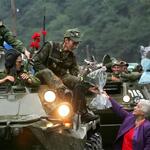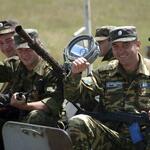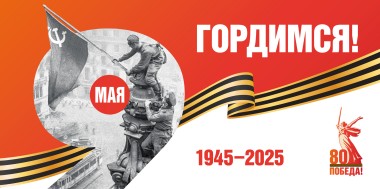July 14 is the 28th anniversary of a significant event in the history of the Ossetian people – the introduction of a Mixed peacekeeping force in the zone of the Georgian-Ossetian conflict on July 14, 1992. We should recall the international political environment in which the decision to deploy a peacekeeping force was made, as well as the actual deployment and start of operation.
The coming to power in Georgia of the extremely nationalistic, chauvinistic forces manipulated by the United States of America under the leadership of Zviad Gamsakhurdia in 1990 led to the military aggression of Georgia against South Ossetia in 1991.
The inhabitants of South Ossetia, instantly found themselves in an energy, information, food and military blockade, were amazed, if not shocked, by what was happening.
It is difficult to list all the hardships and needs of the Tskhinval residents during the year and a half of the war and blockade. The shelling of Tskhinval was taking place almost every day. When Tskhinval was not fired upon, it was considered such a sensation that the press service of the President of Georgia spread a special sensational statement to the whole world that Tskhinval was not subjected to artillery shelling today.
To the shelling it should be added the military and food blockade of Tskhinval. For several months, every delivery of food to Tskhinval became an event. Moreover, by order of the Tskhinvali Trade Directorate, food products were removed from Tskhinval's food stores under the cover of night. A great achievement was the delivery of German humanitarian aid-dry rations of the West German army. To the starving people, the simple soldier's food seemed like a delicacy.
It is amazing that in such conditions, under shelling, the institute, schools, hospitals and a number of other institutions were functioning.
Replacing Zviad Gamsakhurdia, the triumvirate of Kitovani, Sigua and Ioseliani, and then Eduard Shevardnadze brought to power by them, not only did not stop, but also intensified repressions against Ossetians. If under Gamsakhurdia Tskhinval was fired mainly at night, then under Shevardnadze the shelling began to be fired during the day. And from about June 1, the shelling became completely continuous, both day and night.
The situation in South Ossetia extremely negatively affected the situation in North Ossetia, which is part of the Russian Federation. A crowd of thousands gathered in the center of Vladikavkaz for several days, which called for urgent measures. Fearing the situation would get out of control, the republic’s leadership, in turn, exerted corresponding pressure on the federal center.
A significant role was also played by the emergency television speeches of the Vice President of Russia Alexander Rutskoy and the Chairman of the Supreme Council of Russia Ruslan Khasbulatov, who harshly demanded that Georgia immediately cease shelling of Tskhinval, openly threatening otherwise to launch a missile bomb attack on Tbilisi by Russian aviation forces. .
Russian President Boris Yeltsin also met in March 1991 with Georgian President Zviad Gamsakhurdia to politely demand that he end the war in South Ossetia. Gamsakhurdia did not appreciate the politeness of the leader of Russia, in translation from diplomatic to generally understood, he simply laughed at him. Yeltsin saw that his opponents could use the delay in this matter to their advantage. He brought to the new leader of Georgia, Shevardnadze, that Russia was taking the situation very seriously. However, Shevardnadze made joking, foolish remarks, in response to which Yeltsin had to bring down all the power of his anger on an innocent table. This created favorable conditions for Georgia to understand the importance of the current moment, and it considered it good to sign the Sochi Agreement on the basic principles for resolving the Georgian-Ossetian conflict.
July 13, 1992 Georgian artillery for some time stopped shelling Tskhinval. Exhausted from a long stay in the basements and shelters, people took to the streets to enjoy the sunshine and stretch their legs. People were surprised, did the troops of the State Council of Georgia decide to prematurely begin a truce? And then the shelling resumed with renewed vigor, exposing the insidious plan of the Georgian military command. Many people were killed literally in the last minutes of the war.
On the morning of July 14, 1992, trilateral peacekeeping forces entered the permanent deployment places in the Georgian-Ossetian conflict zone. The location of the Joint Headquarters was the military unit in the center of Tskhinval near the institute building.
The sixteen-year process of the peaceful settlement of the Georgian-Ossetian conflict began, which for the time being was called the most successful peacekeeping operation in the whole world until August 7, 2008 - until the day of the treacherous start of the full-scale military aggression of Georgia against South Ossetia and Russia.
In South Ossetia, one of the central streets of Tskhinval is named after in tribute to the memory of the peacekeepers. There is also a memorial stele there.










